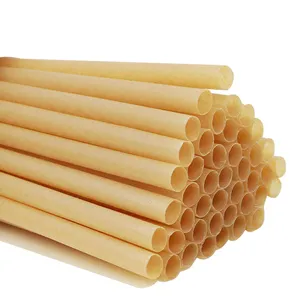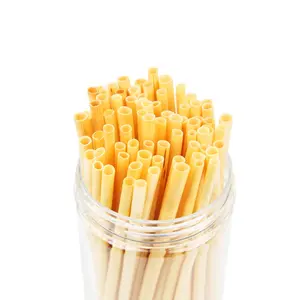

220mm Biodegradable Disposable Sugarcane Bagasse Paper Pulp Sugarcane Bagasse Customrised Size Drinking Straws


Eco Friendly 100% Biodegradable Grass Disposable Wheat Tube Straws Custom Packing Organic Drinking Straws



















In an era where sustainability is paramount, the quest for eco-friendly alternatives has led us to explore the potential of straw grass. This by-product of cereal grain grasses, often overlooked, offers a unique solution for a lush, low-maintenance lawn. This article delves into the nature of straw grass, its eco-friendly attributes, and its low-maintenance benefits. We'll also explore how to install and care for straw grass lawns, compare it with traditional lawns, and share success stories of lawn transformations using this remarkable material.
Straw is a by-product of cereal grain grasses like wheat, rye, and barley. After the grain-bearing seed head is harvested, the hollow stems or straw remain. These are baled up in rectangular shapes, similar to hay. The hollow stems make for good insulating material and have been used for centuries as warm bedding for animals. Straw is also used for spreading on the ground, as a covering for lawn seed, or for mulching vegetable gardens. It has many uses, but it's not a food staple.
Grass straws are a sustainable and eco-friendly alternative to plastic straws. Made from natural gray sedge, these straws are 100% biodegradable and compostable. They help reduce plastic waste and provide a safe, natural alternative for both hot and cold beverages. The production process is environmentally friendly, utilizing little to no water, protecting soil quality, and keeping pollutants out of the environment. Once discarded, grass straws provide organic nutrition to the soil rather than sit in landfills like plastic ones. They have a shorter life cycle than synthetic counterparts and break down fast when composted or exposed to sunlight or rainwater.
Straw grass offers several low-maintenance benefits. Firstly, it helps lock in moisture, reducing the need for frequent watering. It also prevents seed movement, ensuring uniform growth and preventing patchy areas. Straw grass is easy to apply and clean up, with some types decomposing into the soil over time, adding nutrients and organic matter. However, it's important to apply it correctly; too thick a layer can inhibit grass seed growth. Despite its benefits, straw grass can be a bit messy and may damage new grass during removal if not done correctly.
Straw grass lawns require specific care for successful installation and growth. Begin by preparing the soil, removing any existing grass and debris, and evening out the surface. Seed your lawn and feed it on the same day to give the new grass a head start. After seeding, cover the area with a thin layer of soil to prevent the seeds from drying out. Regular watering is crucial, keeping the top inch of soil consistently moist. Once the grass reaches a mowing height of around 3 inches, reduce watering to about twice per week. Maintain your lawn by mowing it at a high setting and avoiding excessive foot traffic.
Straw is often recommended as a cover for newly seeded lawns to retain moisture. However, it's not the only or the best option. A better alternative is a seeding mulch that absorbs thrice its weight in water, keeping the soil surface moist. Unlike straw, it doesn't blow away, introduce weed seeds, or require raking as it biodegrades quickly. It also protects the seed from sun, birds, and soil erosion, and adds organic matter and nutrition to the soil.
The original content shares a success story of lawn transformation using grass seed and fertilization. The lawn was initially in a poor state due to heavy machinery and construction. However, after seeding the lawn and applying fertilizer, the lawn showed significant improvement. An Erosion Control Blanket was also used to protect the newly seeded areas. The grass started sprouting within 3 days of planting, and the lawn is now lush and green. This case study demonstrates the effectiveness of proper lawn care and maintenance.
Straw grass presents a compelling, eco-friendly solution for those seeking a lush, low-maintenance lawn. Its sustainable nature, coupled with its ability to lock in moisture and prevent seed movement, makes it an excellent choice for lawn care. While it may not be the best option for every situation, as alternatives like seeding mulch offer additional benefits, straw grass still holds its own. The success stories shared in this article underscore the potential of straw grass when used correctly. As we continue to prioritize sustainability, straw grass offers a promising path forward for eco-conscious lawn care.